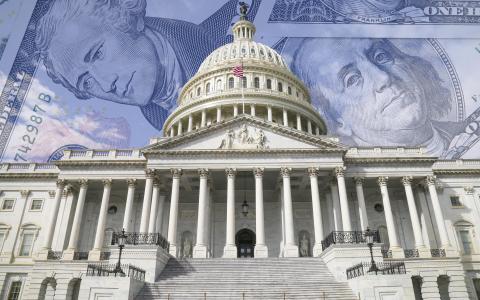
(Opinion - Yahoo!Finance) - Financial markets are sending the politicians in Washington, D.C., an urgent message: It’s time to start dealing with the gargantuan national debt.
Congress’s response: Nah. Instead, we’ll issue more debt.
Few people in the nation’s capital seem to be noticing what’s happening in bond markets, where interest rates are rising in an unusual trading pattern. The 30-year Treasury bond recently crested 5.1%, the highest level since 2007. The 10-year Treasury note has drifted up toward 4.6%, the highest level since February.
Those rates are not inherently problematic on their own. What’s odd, however, is that dollar-denominated rates have been rising at the same time investors perceive higher risk in markets due to the effects of President Trump’s tariffs and a swollen national debt that may finally be reaching crisis proportions.
When investors think risk is rising, they typically put more money into US Treasury securities because of their “safe haven” status. More demand for Treasurys pushes rates down. Volatile markets such as those of the last few months would normally channel more money into Treasurys, lowering rates.
That hasn’t been happening. Instead, rates have been rising, with less money going into Treasurys and some investors selling. This has become known as the “Sell America” trade, a new aversion to US assets among investors who normally can’t get enough of them.
One trigger for the Sell America trade is concern that the reckoning for years of fiscal recklessness has finally arrived. The rating agency Moody’s underscored this on May 16 when it downgraded the US credit rating, the last of three main rating agencies to do so. The US economy is strong, Moody’s said, but “successive US administrations and Congress have failed to agree on measures to reverse the trend of large annual fiscal deficits and growing interest costs."
Investors are zeroed in on the problem. “Is a US government debt crisis imminent?” economist Ed Yardeni of Yardeni Research asked in a recent analysis. “It's possible. Stock and bond investors may be starting to get jittery over … federal deficits and debt.”
Yet instead of heeding the lesson, Republicans who control Congress are well on their way toward passing a tax-cut package that will make the problem considerably worse. The tax-cut bill passed by the House on May 22 will add at least $3 trillion to the national debt during the next decade. The biggest provisions extend a series of tax cuts for individuals that are due to expire at the end of 2025.
The bill now moves to the Senate, which could impose meaningful changes. But if anything, those could add to the cost of the bill. The House version, for instance, includes hundreds of billions of dollars in cuts to Medicaid, the healthcare program for the poor. The Senate could scale those back, producing a final bill that adds even more to the national debt.
The total national debt is now $36 trillion, with the portion held by public investors equivalent to about 100% of US GDP. That’s only going higher. President Trump says he wants to cut government spending through the “DOGE” efficiency commission and other efforts to downsize the bureaucracy. Yet Congress has ratified very few of the “cuts” DOGE has identified, which means the money keeps going out the door. Courts are reversing many of Trump’s other downsizing efforts, saying the president can’t change the shape of government without Congress’s backing.
The biggest driver of spiraling government debt is the unchecked growth of Social Security and Medicare, the automatic-spending programs for seniors. Those programs pay benefits to whoever qualifies, regardless of the cost. Reining in that spending could be politically perilous, since it will likely entail benefit cutbacks for millions plus new taxes on some. Far easier to cut everybody’s taxes than impose austerity measures necessary to get the federal budget under control.
The Trump administration has signaled that it will start focusing on deficits once the tax bill is finalized and signed, perhaps by midsummer. Treasury Secretary Scott Bessent says he wants to cut annual budget deficits by 3% of GDP. It’s about 6.4% of GDP now and would rise to at least 7% of GDP once Congress passes the Trump tax bill, according to the Committee for a Responsible Federal Budget. The odds of Bessent reaching his goal seem to be vanishing.
Bessent, so far, has talked about pulling in more tax revenue from tariffs and boosting growth through a boom in energy production as ways to improve the nation’s fiscal standing. Those are Trump talking points and most economists don’t buy them. Instead, economists expect the tariffs to depress growth while pushing prices higher, risking “stagflation.” Lower energy prices can help, but not if they’re low because the economy is faltering.
Bond markets are the ultimate report card on whether Trump’s economic plan is credible, and for now, the grade is in the neighborhood of a C-. Rising rates are pushing everybody’s borrowing costs higher, making mortgages and car loans more expensive. The government’s own borrowing costs are rising too, which means even more taxpayer dollars will have to go to future interest payments that provide no services or benefits for Americans.
Analysts think a 10-year Treasury rate above 5% — about four-tenths of a point higher than current levels — would cement the arrival of a genuine crisis that might force policymakers to act. “A debt crisis need not be a calamity if it forces Washington to put US fiscal policy on a credible sustainable course,” Yardeni wrote. The time may be coming for Congress to prove whether it’s capable of doing that.
By Rick Newman · Senior Columnist



